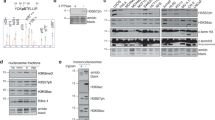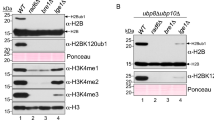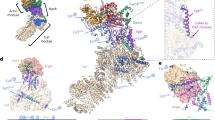Abstract
Histone levels are tightly regulated to prevent harmful effects such as genomic instability and hypersensitivity to DNA-damaging agents due to the accumulation of these highly basic proteins when DNA replication slows down or stops. Although chromosomal histones are stable, excess (non-chromatin bound) histones are rapidly degraded in a Rad53 (radiation sensitive 53) kinase-dependent manner in Saccharomyces cerevisiae. Here we demonstrate that excess histones associate with Rad53 in vivo and seem to undergo modifications such as tyrosine phosphorylation and polyubiquitylation, before their proteolysis by the proteasome. We have identified the Tyr 99 residue of histone H3 as being critical for the efficient ubiquitylation and degradation of this histone. We have also identified the ubiquitin conjugating enzymes (E2) Ubc4 and Ubc5, as well as the ubiquitin ligase (E3) Tom1 (temperature dependent organization in mitotic nucleus 1), as enzymes involved in the ubiquitylation of excess histones. Regulated histone proteolysis has major implications for the maintenance of epigenetic marks on chromatin, genomic stability and the packaging of sperm DNA.
This is a preview of subscription content, access via your institution
Access options
Subscribe to this journal
Receive 12 print issues and online access
$209.00 per year
only $17.42 per issue
Buy this article
- Purchase on Springer Link
- Instant access to full article PDF
Prices may be subject to local taxes which are calculated during checkout






Similar content being viewed by others
References
Gunjan, A., Paik, J. & Verreault, A. The emergence of regulated histone proteolysis. Curr. Opin. Genet. Dev. 16, 112–118 (2006).
Han, M., Chang, M., Kim, U. J. & Grunstein, M. Histone H2B repression causes cell-cycle-specific arrest in yeast: effects on chromosomal segregation, replication, and transcription. Cell 48, 589–597 (1987).
Eriksson, P. R. et al. Global regulation by the yeast Spt10 protein is mediated through chromatin structure and the histone upstream activating sequence elements. Mol. Cell. Biol. 25, 9127–9137 (2005).
Myung, K., Pennaneach, V., Kats, E. S. & Kolodner, R. D. Saccharomyces cerevisiae chromatin-assembly factors that act during DNA replication function in the maintenance of genome stability. Proc. Natl Acad. Sci. USA 100, 6640–6645 (2003).
Nelson, D. M. et al. Coupling of DNA synthesis and histone synthesis in S phase independent of cyclin/cdk2 activity. Mol. Cell. Biol. 22, 7459–7472 (2002).
Ye, X. et al. Defective S phase chromatin assembly causes DNA damage, activation of the S phase checkpoint, and S phase arrest. Mol. Cell 11, 341–351 (2003).
Bonner, W. M., Wu, R. S., Panusz, H. T. & Muneses, C. Kinetics of accumulation and depletion of soluble newly synthesized histone in the reciprocal regulation of histone and DNA synthesis. Biochemistry 27, 6542–6550 (1988).
Groth, A. et al. Human Asf1 regulates the flow of S phase histones during replicational stress. Mol. Cell 17, 301–311 (2005).
Gunjan, A. & Verreault, A. A Rad53 kinase-dependent surveillance mechanism that regulates histone protein levels in S. cerevisiae. Cell 115, 537–549 (2003).
Steger, D. J. & Workman, J. L. Transcriptional analysis of purified histone acetyltransferase complexes. Methods 19, 410–416 (1999).
Meeks-Wagner, D. & Hartwell, L. H. Normal stoichiometry of histone dimer sets is necessary for high fidelity of mitotic chromosome transmission. Cell 44, 43–52 (1986).
Lengauer, C., Kinzler, K. W. & Vogelstein, B. Genetic instabilities in human cancers. Nature 396, 643–649 (1998).
Osley, M. A. The regulation of histone synthesis in the cell cycle. Annu. Rev. Biochem. 60, 827–861 (1991).
Kaygun, H. & Marzluff, W. F. Translation termination is involved in histone mRNA degradation when DNA replication is inhibited. Mol. Cell. Biol. 25, 6879–6888 (2005).
Guan, K. L. & Dixon, J. E. Protein tyrosine phosphatase activity of an essential virulence determinant in Yersinia. Science 249, 553–556 (1990).
Stern, D. F., Zheng, P., Beidler, D. R. & Zerillo, C. Spk1, a new kinase from Saccharomyces cerevisiae, phosphorylates proteins on serine, threonine, and tyrosine. Mol. Cell. Biol. 11, 987–1001 (1991).
Cheung, P., Allis, C. D. & Sassone-Corsi, P. Signaling to chromatin through histone modifications. Cell 103, 263–271 (2000).
Dai, J. et al. Probing nucleosome function: a highly versatile library of synthetic histone H3 and H4 mutants. Cell 134, 1066–1078 (2008).
Nakanishi, S. et al. A comprehensive library of histone mutants identifies nucleosomal residues required for H3K4 methylation. Nature Struct. Mol. Biol. 15, 881–888 (2008).
Wittschieben, B. O., Fellows, J., Du, W., Stillman, D. J. & Svejstrup, J. Q. Overlapping roles for the histone acetyltransferase activities of SAGA and elongator in vivo. EMBO J. 19, 3060–3068 (2000).
Hershko, A. & Ciechanover, A. The ubiquitin system. Annu. Rev. Biochem. 67, 425–479 (1998).
Commerford, S. L., Carsten, A. L. & Cronkite, E. P. Histone turnover within nonproliferating cells. Proc. Natl Acad. Sci. USA 79, 1163–1165 (1982).
Tsvetkov, S., Ivanova, E. & Djondjurov, L. Metabolic behaviors of the core histones in proliferating Friend cells. Exp. Cell. Res. 180, 94–105 (1989).
Wunsch, A. M. & Lough, J. Histones synthesized at different stages of myogenesis are differentially degraded in myotube cells. J. Cell Physiol. 141, 97–102 (1989).
Haas, A. L. & Bright, P. M. The immunochemical detection and quantitation of intracellular ubiquitin-protein conjugates. J. Biol. Chem. 260, 12464–12473 (1985).
Chen, H. Y., Sun, J. M., Zhang, Y., Davie, J. R. & Meistrich, M. L. Ubiquitination of histone H3 in elongating spermatids of rat testes. J. Biol. Chem. 273, 13165–13169 (1998).
Geng, F. & Tansey, W. P. Polyubiquitylation of histone H2B. Mol. Biol. Cell. 19, 3616–3624 (2008).
Spence, J. et al. Cell cycle-regulated modification of the ribosome by a variant multiubiquitin chain. Cell 102, 67–76 (2000).
Davie, J. R. Peptide mapping of basic proteins by proteolysis in acetic acid/urea-minislab polyacrylamide gels. Anal. Biochem. 144, 522–526 (1985).
Li, W., Nagaraja, S., Delcuve, G. P., Hendzel, M. J. & Davie, J. R. Effects of histone acetylation, ubiquitination and variants on nucleosome stability. Biochem. J. 296, 737–744 (1993).
Hilt, W., Enenkel, C., Gruhler, A., Singer, T. & Wolf, D. H. The PRE4 gene codes for a subunit of the yeast proteasome necessary for peptidylglutamyl-peptide-hydrolyzing activity. Mutations link the proteasome to stress- and ubiquitin-dependent proteolysis. J. Biol. Chem. 268, 3479–3486 (1993).
Ghislain, M., Udvardy, A. & Mann, C. S. cerevisiae 26S protease mutants arrest cell division in G2/metaphase. Nature 366, 358–362 (1993).
McGrath, J. P., Jentsch, S. & Varshavsky, A. UBA1: an essential yeast gene encoding ubiquitin-activating enzyme. EMBO J. 10, 227–236 (1991).
Seufert, W. & Jentsch, S. Ubiquitin-conjugating enzymes Ubc4 and Ubc5 mediate selective degradation of short-lived and abnormal proteins. EMBO J. 9, 543–550 (1990).
Robzyk, K., Recht, J. & Osley, M. A. Rad6-dependent ubiquitination of histone H2B in yeast. Science 287, 501–504 (2000).
Ardley, H. C. & Robinson, P. A. E3 ubiquitin ligases. Essays Biochem. 41, 15–30 (2005).
English, C. M., Adkins, M. W., Carson, J. J., Churchill, M. E. & Tyler, J. K. Structural basis for the histone chaperone activity of Asf1. Cell 127, 495–508 (2006).
Pellicioli, A. et al. Activation of Rad53 kinase in response to DNA damage and its effect in modulating phosphorylation of the lagging strand DNA polymerase. EMBO J. 18, 6561–6572 (1999).
Paulovich, A. G. & Hartwell, L. H. A checkpoint regulates the rate of progression through S phase in S. cerevisiae in response to DNA damage. Cell 82, 841–847 (1995).
Longtine, M. S. et al. Additional modules for versatile and economical PCR-based gene deletion and modification in Saccharomyces cerevisiae. Yeast 14, 953–961 (1998).
Lee, S. J., Schwartz, M. F., Duong, J. K. & Stern, D. F. Rad53 phosphorylation site clusters are important for Rad53 regulation and signaling. Mol. Cell. Biol. 23, 6300–6314 (2003).
Mayor, T., Lipford, J. R., Graumann, J., Smith, G. T. & Deshaies, R. J. Analysis of polyubiquitin conjugates reveals that the Rpn10 substrate receptor contributes to the turnover of multiple proteasome targets. Mol. Cell. Proteomics 4, 741–751 (2005).
Peng, J. et al. A proteomics approach to understanding protein ubiquitination. Nature Biotech. 21, 921–926 (2003).
Santisteban, M. S., Arents, G., Moudrianakis, E. N. & Smith, M. M. Histone octamer function in vivo: mutations in the dimer–tetramer interfaces disrupt both gene activation and repression. EMBO J. 16, 2493–2506 (1997).
White, C. L., Suto, R. K. & Luger, K. Structure of the yeast nucleosome core particle reveals fundamental changes in internucleosome interactions. EMBO J. 20, 5207–5218 (2001).
Tagami, H., Ray-Gallet, D., Almouzni, G. & Nakatani, Y. Histone H3.1 and H3.3 complexes mediate nucleosome assembly pathways dependent or independent of DNA synthesis. Cell 116, 51–61 (2004).
Varshavsky, A. The N-end rule: functions, mysteries, uses. Proc. Natl Acad. Sci. USA 93, 12142–12149 (1996).
Thrower, J. S., Hoffman, L., Rechsteiner, M. & Pickart, C. M. Recognition of the polyubiquitin proteolytic signal. EMBO J. 19, 94–102 (2000).
Utsugi, T. et al. Yeast tom1 mutant exhibits pleiotropic defects in nuclear division, maintenance of nuclear structure and nucleocytoplasmic transport at high temperatures. Gene 234, 285–295 (1999).
Saleh, A. et al. TOM1p, a yeast hect-domain protein which mediates transcriptional regulation through the ADA/SAGA coactivator complexes. J. Mol. Biol. 282, 933–946 (1998).
Shan, X., Xue, Z. & Mélèse, T. Yeast NPI46 encodes a novel prolyl cis-trans isomerase that is located in the nucleolus. J. Cell Biol. 126, 853–862 (1994).
Meistrich, M. L. in Histones and other Basic Nuclear Proteins (eds Hnilica, L.S., Stein, G.S. & Stein, J.L.) Ch. 4, 165–182 (CRC Press, 1989).
Rajapurohitam, V., Morales, C. R., El-Alfy, M., Lefrançois, S., Bedard, N. & Wing, S. S. Activation of a UBC4-dependent pathway of ubiquitin conjugation during postnatal development of the rat testis. Dev. Biol. 212, 217–228 (1999).
Wing, S. S., Bedard, N., Morales, C., Hingamp, P. & Trasler, J. A novel rat homolog of the Saccharomyces cerevisiae ubiquitin-conjugating enzymes Ubc4 and Ubc5 with distinct biochemical features is induced during spermatogenesis. Mol. Cell. Biol. 16, 4064–4072 (1996).
Liu, Z., Oughtred, R. & Wing, S. S. Characterization of E3Histone, a novel testis ubiquitin protein ligase which ubiquitinates histones. Mol. Cell. Biol. 25, 2819–2831 (2005).
Krogan, N. J. et al. Proteasome involvement in the repair of DNA double-strand breaks. Mol. Cell 16, 1027–1034 (2004).
Tsukuda, T., Fleming, A. B., Nickoloff, J. A. & Osley, M. A. Chromatin remodelling at a DNA double-strand break site in Saccharomyces cerevisiae. Nature 438, 379–383 (2005).
Collins, K. A., Furuyama, S. & Biggins, S. Proteolysis contributes to the exclusive centromere localization of the yeast Cse4/CENP-A histone H3 variant. Curr. Biol. 14, 1968–1972 (2004).
Moreno-Moreno, O., Torras-Llort, M. & Azorin, F. Proteolysis restricts localization of CID, the centromere-specific histone H3 variant of Drosophila, to centromeres. Nucleic Acids Res. 34, 6247–6255 (2006).
Ullrich, O. et al. Poly-ADP ribose polymerase activates nuclear proteasome to degrade oxidatively damaged histones. Proc. Natl Acad. Sci. USA 96, 6223–6228 (1999).
Kushnirov, V. V. Rapid and reliable protein extraction from yeast. Yeast 16, 857–860 (2000).
Matuschewski, K., Hauser, H. P., Treier, M. & Jentsch, S. Identification of a novel family of ubiquitin-conjugating enzymes with distinct amino-terminal extensions. J. Biol. Chem. 271, 2789–2794 (1996).
Acknowledgements
We thank J. Diffley, D. Finley, M. Hochstrasser, S. Jentsch, N. Lowndes, C. Mann, H. Masumoto, M. A. Osley, R. Rothstein, D. Stern, D. Stillman, J. Svejstrup, A. Verreault and Y. Wang for strains and reagents, A. Verreault and D. Brown for critical reading of this manuscript, M. Abdul-Rauf for construction of the pYES2–HTH and pYES2–HTH–HHT2 plasmids, as well as the H4 mutants used in the Supplementary Information and undergraduate students S. Eckley and M. Gonzalez for technical assistance with the collection of many litres of yeast cultures for our experiments. We thank M. Blaber for assistance with the structural modelling of the Y 99 residue of histone H3, shown in Supplementary Information, Fig. S8. Research in AG's laboratory is supported by a Bankhead-Coley Cancer Research Program grant (07BN-02) from the Florida Department of Health and research in JP's laboratory is funded by a NIH grant (R15GM079678-01).
Author information
Authors and Affiliations
Contributions
R.K.S. performed 70% of the experiments, aided in the design of several experiments and helped write parts of the manuscript; M.M.K. carried out 5% of the experiments, provided technical support and assisted R.K.S. as well as A.G. with experiments; J.P. aided in the conceptual design of some experiments and helped with manuscript preparation; A.G. performed 25% of the experiments, was in charge of the overall design of experiments and wrote the manuscript with help from R.K.S. and J.P.
Corresponding author
Ethics declarations
Competing interests
The authors declare no competing financial interests.
Supplementary information
Supplementary Information
Supplementary Information (PDF 1478 kb)
Rights and permissions
About this article
Cite this article
Singh, R., Kabbaj, MH., Paik, J. et al. Histone levels are regulated by phosphorylation and ubiquitylation-dependent proteolysis. Nat Cell Biol 11, 925–933 (2009). https://doi.org/10.1038/ncb1903
Received:
Accepted:
Published:
Issue Date:
DOI: https://doi.org/10.1038/ncb1903
This article is cited by
-
Histone tyrosine sulfation by SULT1B1 regulates H4R3me2a and gene transcription
Nature Chemical Biology (2023)
-
Histone 3.3-related chromatinopathy: missense variants throughout H3-3A and H3-3B cause a range of functional consequences across species
Human Genetics (2023)
-
Mechanisms of gene regulation by histone degradation in adaptation of yeast: an overview of recent advances
Archives of Microbiology (2022)
-
Multilayered regulation of proteome stoichiometry
Current Genetics (2021)
-
HUWE1 employs a giant substrate-binding ring to feed and regulate its HECT E3 domain
Nature Chemical Biology (2021)



